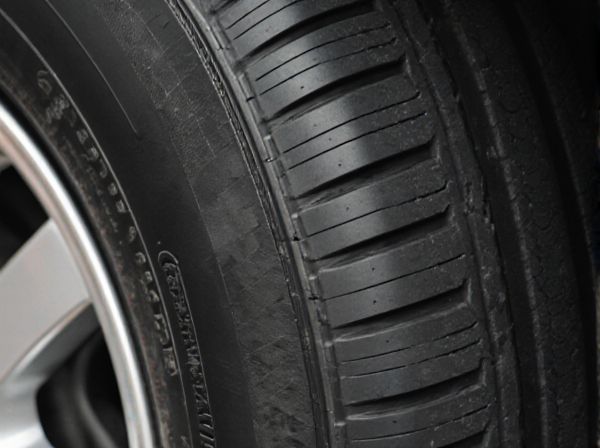
Photo illustration: Ribbed Tire vs Lugged Tire
Ribbed tires offer smooth steering and enhanced stability on paved roads, making them ideal for highway and urban riding. Lugged tires provide superior traction on rough terrain, with deep treads that grip loose or muddy surfaces effectively. Choosing the right tire depends on your riding conditions, ensuring optimal performance and safety.
Table of Comparison
| Feature | Ribbed Tire | Lugged Tire |
|---|---|---|
| Tread Design | Continuous ribs, linear pattern | Deep, aggressive lugs |
| Primary Use | On-road, smooth surfaces | Off-road, muddy and rough terrains |
| Traction | Good for steering and stability | High traction on soft, uneven ground |
| Durability | Moderate tread wear, less debris buildup | Robust, designed to resist cuts and punctures |
| Fuel Efficiency | Better fuel economy due to low rolling resistance | Lower fuel efficiency, higher rolling resistance |
| Noise Level | Low road noise | Higher noise on paved roads |
| Best For | Highway driving, city roads | Construction, agriculture, off-road vehicles |
Introduction to Ribbed and Lugged Tires
Ribbed tires feature continuous, rib-like patterns designed to enhance steering control and minimize soil disturbance, making them ideal for smooth terrains and row-crop farming. Lugged tires incorporate deep, angled lugs that provide superior traction and self-cleaning capabilities, suited for muddy or uneven off-road conditions. Choosing between ribbed and lugged tires depends on the specific agricultural or industrial application, terrain type, and required traction.
What Are Ribbed Tires?
Ribbed tires feature continuous ribs running parallel to the tread, designed primarily for steering and cornering on hard surfaces such as paved roads. These tires provide minimal rolling resistance and enhanced stability by maximizing contact with the road, making them ideal for front wheels of tractors and other agricultural machinery. Their smooth, ribbed pattern also aids in precise directional control, especially in soft or muddy soil conditions.
What Are Lugged Tires?
Lugged tires feature deep, aggressive tread patterns designed to provide enhanced traction on loose or uneven surfaces such as mud, dirt, and snow. These tires are equipped with large, protruding lugs that dig into soft terrain to improve grip and stability, making them ideal for off-road vehicles and heavy machinery. Compared to ribbed tires, which are optimized for smooth surfaces and directional control, lugged tires excel in rugged environments by offering superior durability and traction.
Design Differences: Ribbed vs Lugged Tread Patterns
Ribbed tires feature continuous, straight grooves that enhance steering precision and stability on smooth surfaces, optimized for highway and city driving conditions. Lugged tires have aggressive, protruding tread blocks designed for superior traction on rough, muddy, or off-road terrains, improving grip and self-cleaning capabilities. The fundamental design difference lies in ribbed tires' emphasis on reducing rolling resistance and noise, while lugged tires prioritize durability and off-road performance through deeper, spaced-out lugs.
Traction Performance: Ribbed vs Lugged Tires
Ribbed tires feature continuous ribs that provide excellent straight-line stability and reduced rolling resistance, making them ideal for hard-packed surfaces. Lugged tires have deep, aggressive tread patterns designed to dig into soft soils, offering superior traction on muddy or loose terrain. The choice between ribbed and lugged tires significantly impacts traction performance, with ribbed tires excelling on firm ground and lugged tires outperforming in off-road conditions.
Applications: Best Uses for Each Tire Type
Ribbed tires excel in highway applications and paved road conditions, providing superior stability, smooth handling, and better fuel efficiency due to their continuous rib patterns that enhance traction on hard surfaces. Lugged tires are ideal for off-road and agricultural use, offering enhanced grip and self-cleaning capabilities on soft, muddy, or uneven terrain thanks to their deep, aggressive tread design. Choosing ribbed tires benefits long-distance trucking and commercial vehicles operating on asphalt, while lugged tires are preferred for construction equipment, tractors, and vehicles that navigate challenging off-road environments.
Durability and Maintenance Comparison
Ribbed tires offer enhanced durability on paved roads due to their uniform tread pattern that evenly distributes wear, reducing maintenance frequency. Lugged tires excel in off-road durability, with deep, aggressive tread blocks that resist cuts and punctures, though they require more frequent inspection for embedded debris and tread wear. Maintenance for ribbed tires typically involves routine pressure checks, while lugged tires demand thorough cleaning and regular tread depth monitoring to maintain optimal performance.
Ride Comfort and Stability Analysis
Ribbed tires provide superior ride comfort due to their continuous tread pattern, which reduces road noise and vibration, enhancing smoothness on paved surfaces. Lugged tires excel in stability by offering deeper, aggressive tread blocks that improve traction and control on uneven or off-road terrain. The optimal choice depends on balancing the need for cushioned, quiet rides with traction demands for varied surface conditions.
Cost Considerations: Ribbed vs Lugged Tires
Ribbed tires generally cost less than lugged tires due to simpler tread patterns and lower manufacturing complexity, making them a budget-friendly option for light to moderate use. Lugged tires, designed for heavy-duty traction and off-road conditions, tend to be more expensive because of advanced rubber compounds and reinforced sidewalls that enhance durability. Choosing between ribbed and lugged tires involves balancing upfront cost against performance needs and tire longevity in specific driving environments.
Choosing the Right Tire for Your Needs
Ribbed tires offer enhanced maneuverability and reduced rolling resistance, making them ideal for smooth surfaces and urban commuting, while lugged tires provide superior traction and durability on rough, off-road terrains due to their deep tread patterns. Choosing the right tire depends on your primary riding environment: opt for ribbed tires for speed and efficiency on pavement, and select lugged tires for grip and stability in mud, dirt, or rocky conditions. Consider factors like terrain type, weather conditions, and riding style to ensure optimal performance and safety with your tire choice.
 caratoz.com
caratoz.com